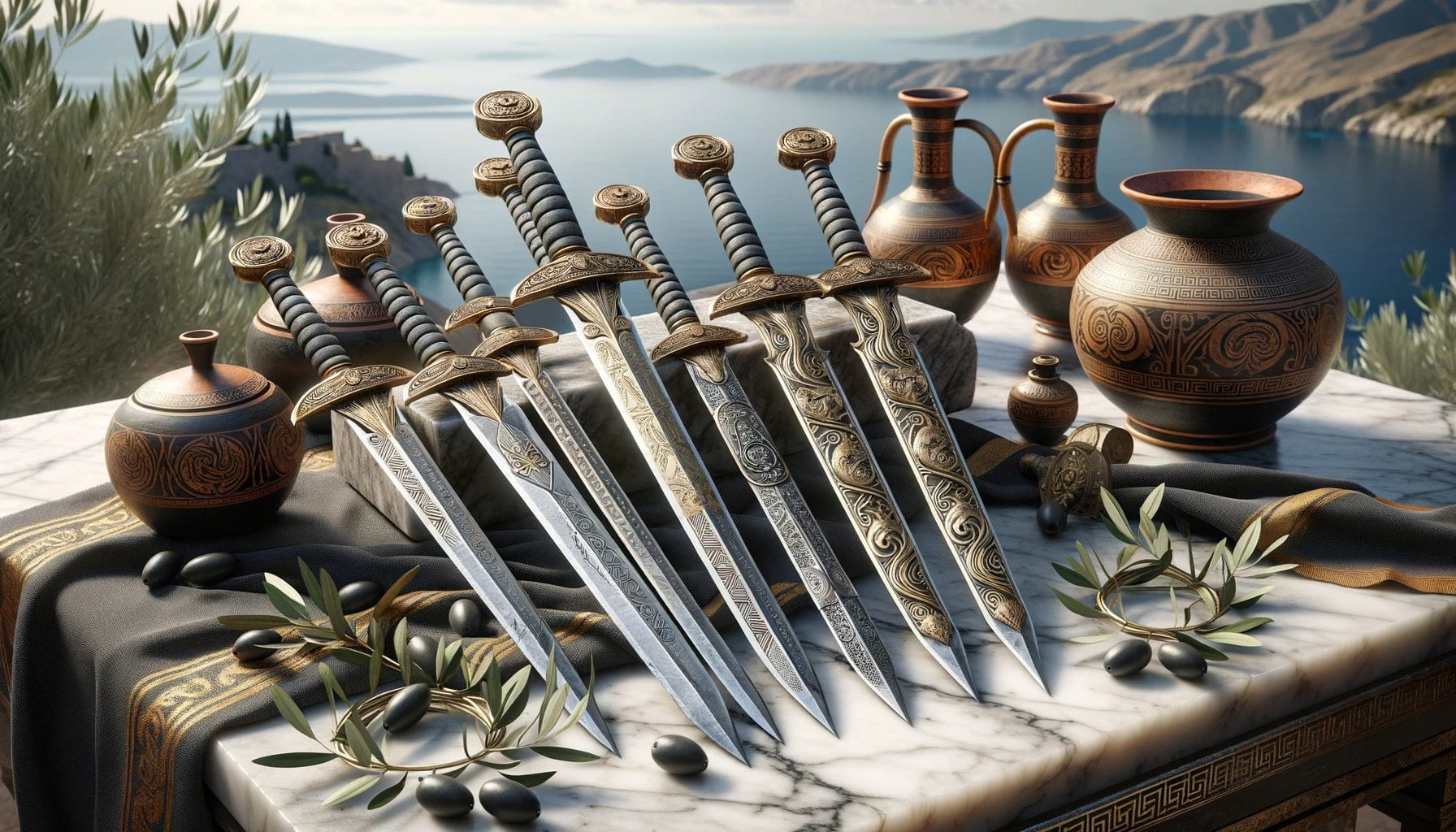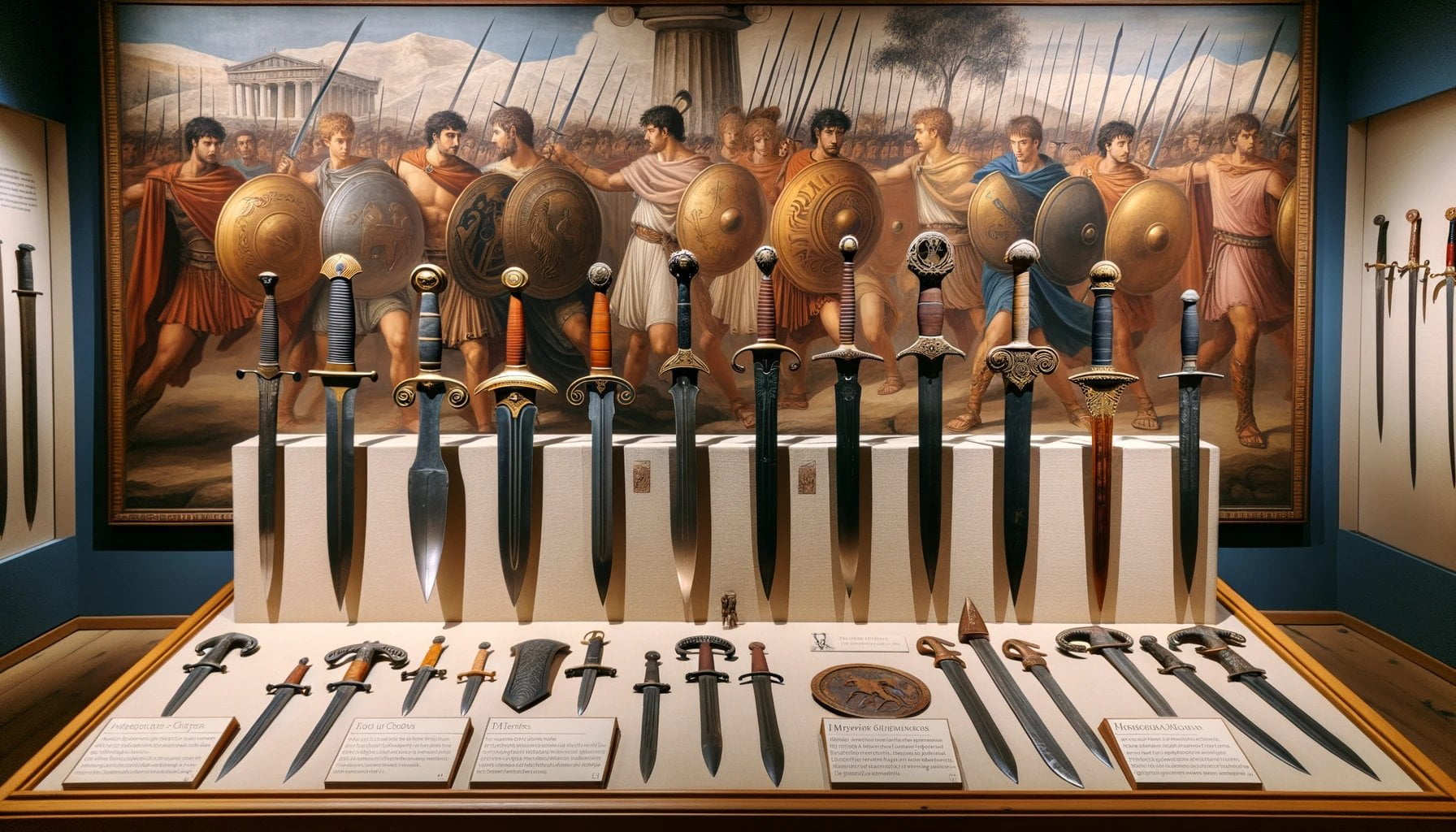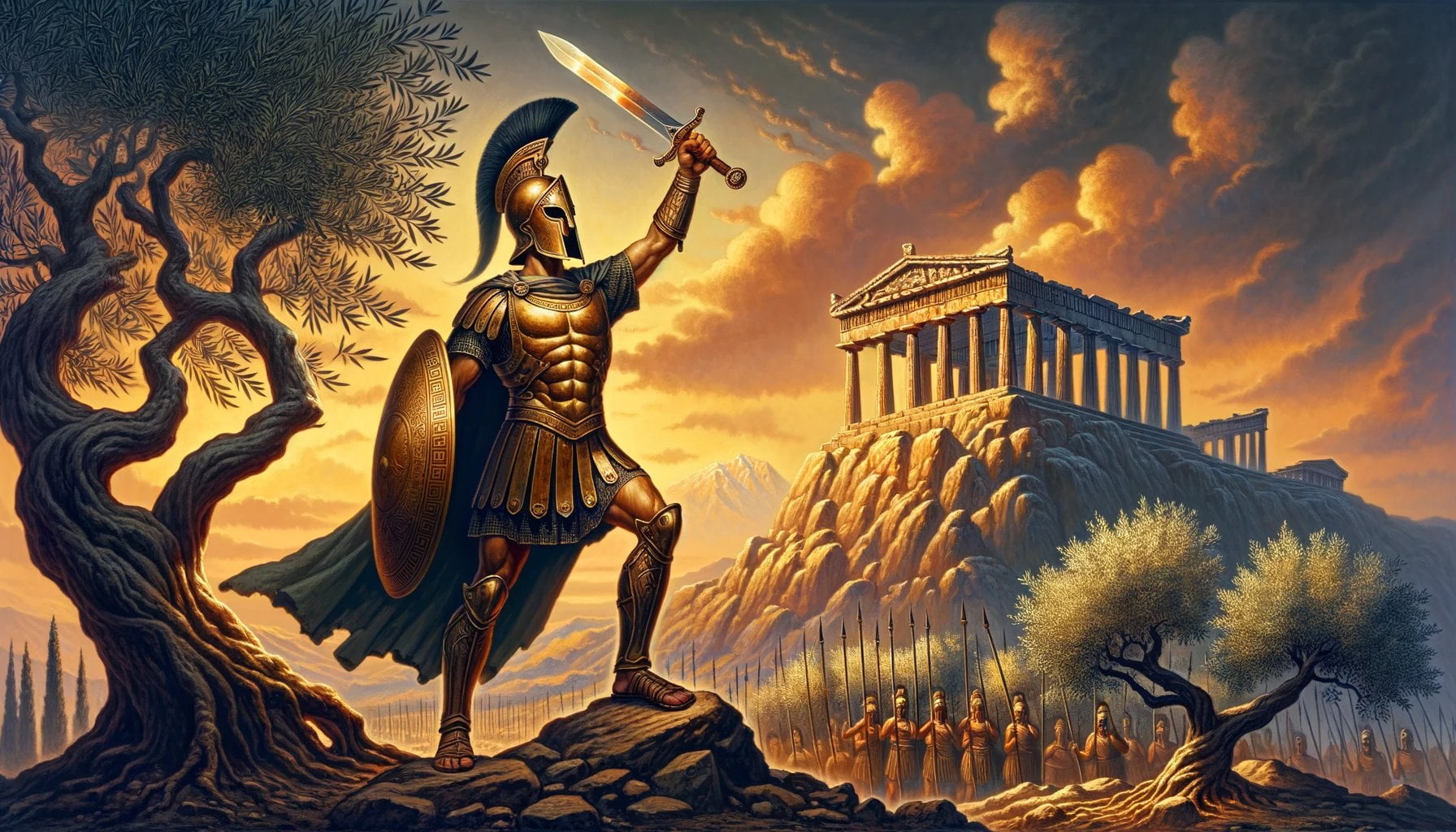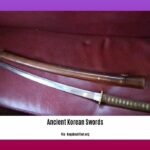As we delve into the captivating realm of Ancient Greece, we find ourselves enchanted by the tales of mighty warriors and epic battles. At the heart of these ancient legends lie the extraordinary swords that adorned the hands of Greek warriors. These weapons not only possessed exceptional craftsmanship and design, but also held a profound cultural and symbolic significance. Join us on a mesmerizing journey through time as we explore the various types of ancient Greek swords, unravel their unique characteristics, and uncover the rich history that surrounds these authentic relics. Prepare to be immersed in the legacy and splendor of the swords that shaped Greek warfare and left an indelible mark on their society.
Key Takeaways:
- The ancient Greeks used a variety of swords, including the falcata, kopis, xiphos, and rhomphaia, for different purposes such as slashing and thrusting.
- Replicas of Greek swords such as the Spartan sword, Trojan short sword, and sword of Alexander the Great can be purchased from websites like battlingblades.com and medievalcollectibles.com.
- Greek swords were typically made from materials like copper, bronze, and iron, with the xiphos being a popular one-handed short sword with a double-edged blade.
- Greek swords differed from Roman swords in terms of design and function, with Greek swords primarily used for thrusting and having leaf-shaped blades, while Roman swords were longer and used for slashing and thrusting.
- Engravings of symbols were common on Greek swords, although specific information about these symbols is not mentioned in the given context.
- Additional information on Greek swords can be found on websites such as battlingblades.com and swordencyclopedia.com’s entry on the xiphos sword.
Swords of Ancient Greece

The ancient Greeks were skilled warriors who wielded a range of swords with distinct designs and functions. These swords played a significant role in shaping Greek history and remain fascinating artifacts of their time. In this article, we will explore the intriguing world of ancient Greek swords, shedding light on their history, significance, and unique features.
The Varied Types of Greek Swords
Ancient Greece boasted a rich variety of swords, each with its own shape, length, and purpose. Among the most well-known are the falcata, kopis, xiphos, and rhomphaia. These swords were carefully crafted to accommodate different combat techniques, allowing Greek warriors to adapt to various battle situations.
The falcata is a curved sword known for its distinctive blade, which provides added power to the slashing attacks of its wielder. The kopis, on the other hand, has a forward-curving blade, making it ideal for both chopping and slicing movements. Meanwhile, the xiphos, a one-handed double-edged short sword, excelled in thrusting actions. Lastly, the rhomphaia featured a long blade with a single edge, enabling warriors to strike formidable blows from a distance.
Materials and Design
Greek swords were crafted using materials such as copper, bronze, and iron. The xiphos, a beloved Greek sword, boasted a leaf-shaped blade, allowing for both cutting and thrusting maneuvers. Its design perfectly balanced functionality and elegance, making it a true masterpiece of ancient Greek craftsmanship.
Contrasting Greek and Roman Swords
It is important to note the distinctions between Greek and Roman swords. While Greek designs favored thrusting actions with their leaf-shaped blades, Roman swords were longer and primarily used for both slashing and thrusting. This divergence in design reflects the differing combat tactics of the two civilizations.
Symbols Engraved in Greek Swords
Greek swords often featured intricate engravings and symbols, adding a layer of symbolism and artistry to these formidable weapons. While specific information about the symbols engraved on Greek swords is not provided in this context, it is worth exploring the significance of these symbols in future research.
Exploring Further
If you are eager to delve deeper into the world of Greek swords, there are additional resources available. The website Battling Blades – Greek Swords offers a comprehensive selection of Greek sword replicas, providing a tangible connection to these ancient weapons. Additionally, the Sword Encyclopedia offers valuable insights and information specifically on the xiphos sword.
In conclusion, the swords of ancient Greece are a testament to the skill and craftsmanship of Hellenistic cultures. From the falcata to the xiphos, each sword bears its own unique history and significance. By understanding the design and purpose behind these weapons, we can unravel their role in ancient military tactics and the impact they had on Greek society. So, embark on this journey of discovery and immerse yourself in the captivating world of Greek swords.
Swords of Ancient Greece were not only wielded by warriors, but also by gods and heroes of ancient Greece, who possessed immense power and bravery. Discover the legends and tales surrounding these iconic weapons in our article on gods and heroes of ancient Greece. Whether it’s the mythical stories or the historical significance, this fascinating topic is bound to captivate your imagination. Click here to dive into the rich tapestry of ancient Greek mythology and history.
History of Greek Swords
The Xiphos: The Leaf-Shaped Sword
The xiphos was the preferred sword of Greek heavy infantry hoplites during Ancient Greece. With its leaf-shaped blade, the xiphos was a versatile weapon that allowed for cutting and thrusting maneuvers on the battlefield. Made of copper, bronze, or iron, the xiphos showcased the exceptional craftsmanship of the era. Ranging from 19 to 23 inches in length, this formidable sword played a crucial role in Greek warfare.
Source: Sword Encyclopedia: Most Popular Greek Swords and Their Historical Uses
The Kopis: The Sword Suited for Mounted Warfare
While the kopis was less popular than the xiphos, it offered distinct advantages in mounted warfare. This sword had a single-edged, forward-curving blade, making it ideal for powerful slashing attacks from horseback. While heavy infantry hoplites favored straight swords, cavalry soldiers preferred the kopis. Similar to the xiphos, the kopis was typically made of copper, bronze, or iron, showcasing the advancements in ancient Greek weaponry.
Source: Wikipedia: Kopis
Swords as Symbols of Power and Craftsmanship
Beyond their practical use as weapons, swords held great symbolism in ancient Greek society. Considered true works of art, they captured the power and technological sophistication of the era. Greek swords were often adorned with intricate designs, showcasing the remarkable craftsmanship of the period. These swords continue to leave a lasting legacy through art and pottery, allowing us to appreciate the artistic and technological achievements of ancient Greece.
Sources: Minikatana: Ancient Greek Swords: The Weapons that Shaped an Empire
Key Takeaways:
- Ancient Greek swords, such as the xiphos and kopis, played a significant role in Greek warfare.
- The xiphos, with its leaf-shaped blade, was the preferred sword of Greek heavy infantry hoplites.
- The kopis, with its forward-curving blade, was well-suited for mounted warfare and favored by cavalry soldiers.
- Greek swords not only served as weapons but also symbolized power and showcased the technological advancements of ancient Greece.
- Intricate designs on these swords demonstrated the exceptional craftsmanship of the period.
Source: Sword Encyclopedia: Most Popular Greek Swords and Their Historical Uses([2])
Authentic Swords Of Ancient Greece
Ancient Greece, with its rich history and legendary warriors, holds a fascination for many. One of the most intriguing aspects of this ancient civilization is its weaponry, particularly the swords that played a significant role in shaping Greece’s legacy in warfare. In this article, we will unravel the history and significance of the authentic swords of ancient Greece, shedding light on their design, purpose, and impact on Greek society.
Types of Greek Swords
Among the various types of swords used by Greek warriors, two prominent ones stand out: the xiphos and the kopis. The xiphos, with its distinctive leaf-shaped blade, was commonly seen in the hands of Greek hoplites – heavy infantry soldiers. It served as a secondary weapon alongside the thrusting spear known as the dory. The xiphos was a versatile sword, allowing for cutting and thrusting maneuvers on the battlefield.
On the other hand, the kopis or makhaira sword possessed a single-edged, forward-curving blade. This unique curvature made it well-suited for slashing attacks from horseback. While the xiphos was more popular among Greek warriors, the kopis played a vital role in mounted warfare.
Materials and Design
Ancient Greek swords were predominantly crafted from copper, bronze, and iron. These materials showcased the advancements in ancient Greek weaponry, reflecting the technological sophistication of the era. The xiphos, in particular, was considered a well-crafted sword, exemplifying the skill and craftsmanship of Hellenistic cultures.
Greek swords often boasted intricate engravings and symbols, although specific information about these symbols remains limited. The adornments on these swords not only enhanced their visual appeal but also added symbolic meaning, showcasing the power and status associated with wielding such weapons.
Role in Warfare and Society
In ancient Greece, warfare was an integral part of life, with battles between city-states and neighboring enemies being a frequent occurrence. Greek swords, including the xiphos and the kopis, played a crucial role in these conflicts. While the primary weapon of Greek hoplites was the dory, swords like the xiphos served as reliable secondary weapons when engagements required close combat or the spear was rendered ineffective.
Beyond the battlefield, swords held great symbolism in ancient Greek society. They represented not only the military might of the Greeks but also reflected their cultural and technological advancements. Greek swords were not merely tools of war; they found their place in daily activities, ceremonies, and even combat demonstrations, emphasizing their importance in the fabric of Greek tradition.
Unveiling the Legacy
Ancient Greek swords have left their mark not only on the pages of history but also in art, literature, and mythology. Depictions of these swords in paintings, sculptures, and written accounts further highlight their significance in Greek warfare. The leaf-shaped xiphos, in particular, has found its way into Greek mythology, associated with renowned heroes such as Achilles and Perseus.
Excavations in Greece have unearthed ancient bronze swords, providing archaeologists with valuable insights into the weaponry of ancient Greek civilization. These discoveries enable us to appreciate the craftsmanship invested in creating these authentic swords and their enduring legacy.
Key Takeaways:
- The xiphos and kopis were the most popular types of Greek swords, with the xiphos being the preferred weapon of Greek hoplites.
- Ancient Greek swords were made of materials like copper, bronze, and iron, showcasing the advancements of the era.
- Greek swords played a significant role in warfare between city-states and neighboring enemies.
- These swords were not only tools of war but also held symbolic importance in Greek society, representing power and technological sophistication.
- The leaf-shaped xiphos and the curved kopis swords were distinctive to ancient Greece and left an indelible mark on their legacy.
- Excavations in Greece have provided valuable insights into the craftsmanship and design of authentic ancient Greek swords.
Sources:
- Greek Swords – Sword Encyclopedia
- Ancient Greek Swords: The Weapons that Shaped an Empire – Mini Katana

FAQ
Q1: What are the different types of ancient Greek swords?
A1: The different types of ancient Greek swords include the xiphos, kopis, falcata, and rhomphaia.
Q2: What materials were ancient Greek swords made of?
A2: Ancient Greek swords were made of materials such as copper, bronze, and iron.
Q3: What were the main uses of Greek swords in warfare?
A3: Greek swords were primarily used as one-handed weapons for slashing, thrusting, or both, in battles between city-states and neighboring enemies.
Q4: Were Greek swords only used in warfare?
A4: While Greek swords were commonly used in warfare, they were also used in daily activities, ceremonies, and combat.
Q5: What is the significance of the xiphos sword in Greek mythology?
A5: The xiphos sword is referred to in Greek mythology and is associated with famous Greek heroes.
- SYBAU See You Baby Meaning: Gen Z Slang Evolves - July 1, 2025
- Unlock Your Inner Youth: Lifestyle Secrets for a Vibrant Life - July 1, 2025
- Decode SYBAU Meaning: Gen Z Slang Explained - July 1, 2025






